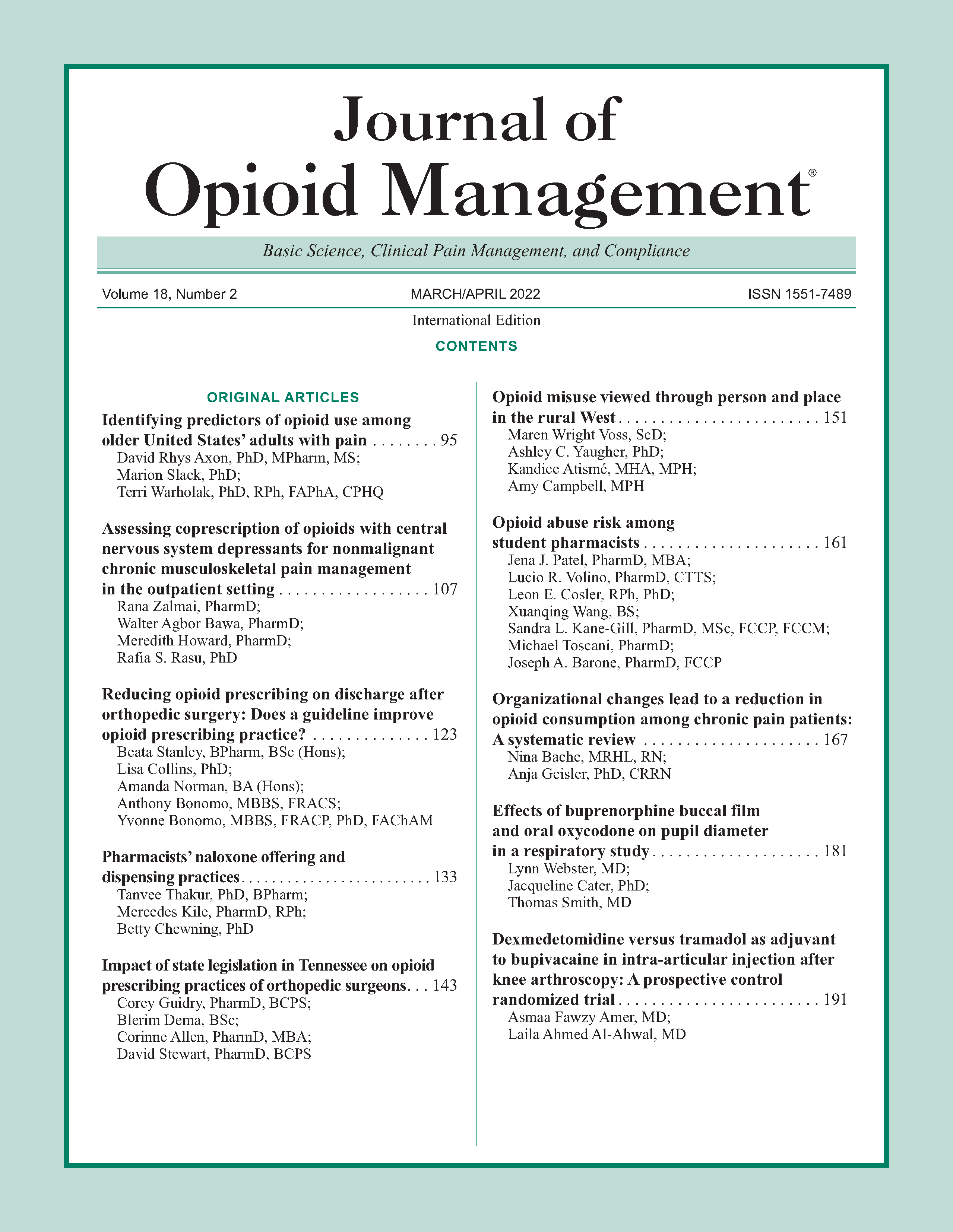Opioid abuse risk among student pharmacists
DOI:
https://doi.org/10.5055/jom.2022.0706Keywords:
chronic pain management, student pharmacists, opioid risk, opioid abuse risk, drug abuse, substance abuseAbstract
Objective: To benchmark opioid abuse risk among student pharmacists attending three northeast pharmacy schools utilizing the opioid risk tool (ORT).
Design: A cross-sectional, anonymous risk assessment questionnaire.
Setting: Three pharmacy schools in the northeast United States.
Participants: Professional year 1 (P1) through professional year 3 (P3) student pharmacists.
Methods: ORT was collected and scored by investigators and inputted into an electronic format for analysis. Students voluntarily participated, and 812 surveys were completed during one course meeting time and day at each school.
Results: The majority of students were in the low-risk category (n = 581, 71.6 percent). Additionally, 137 (16.9 percent) patients were categorized as moderate risk and 94 (11.6 percent) as high risk. No statistically significant differences existed when comparing risk groups across the first through third professional year student pharmacist cohorts. There were no statistically significant differences in the proportion of risk groups among the three pharmacy cohorts between low-risk versus the high-risk groups. When comparing risk groups by gender, males were found to have a statistically significant higher proportion of being classified as moderate or high risk.
Conclusions: The results of this study demonstrate that there may be some student pharmacists with an increased risk for opioid abuse potential. There is potential need for education regarding opioid risk awareness and abuse prevention, which may serve as a call to action for professional school students and practitioners to understand baseline opioid abuse risk if they require chronic pain therapy.
References
CDC injury center: Opioid data analysis and resources. Available at https://www.cdc.gov/drugoverdose/data/analysis.html. Accessed April 30, 2020.
American addiction centers: Alcohol and drug abuse statistics. Available at https://americanaddictioncenters.org/rehabguide/addiction-statistics. Accessed September 23, 2020.
CDC injury center: Prescription opioids. Available at https://www.cdc.gov/drugoverdose/opioids/prescribed.html. Accessed September 27, 2020.
American addiction centers: Statistics for substance abuse in medical professionals. Available at https://americanaddictioncenters.org/rehab-guide/addiction-statistics/medical-professionals. Accessed September 27, 2020.
Butler center for research: Substance abuse in health care professionals. Available at https://www.hazeldenbettyford.org/education/bcr/addiction-research/health-care-professionalssubstance-abuse-ru-615. Accessed September 23, 2020.
Gross SR, Marshall EJ, Wolff K: Substance misuse among health care workers: National survey of occupational physicians. Occup Med (Lond). 2012; 62(4): 254-260.
Yuan BW, Yang I, Simmons DJ, et al.: Evaluation of nonmedical use of prescription stimulants by college students at three northeastern pharmacy schools. J Am Coll Clin Pharm. 2019; 2(5): 525-530.
Addiction center: Addiction in medical professionals. Available at https://www.addictioncenter.com/addiction/medical-professionals/. Accessed September 23, 2020.
American Association of Colleges of Pharmacy: American Association of Colleges of Pharmacy Graduating Student Survey. National Summary Report. 2019. Available at https://www.aacp.org/sites/default/files/2019-07/2019-gss-national-summaryreport_0.pdf. Accessed September 27, 2020.
Webster LR, Webster RM: Predicting aberrant behaviors in opioid-treated patients: Preliminary validation of the opioid risk tool. Pain Med. 2005; 6(6): 432-442.
Practical pain management: Risk assessment: Safe opioid prescribing tools. Available at https://www.practicalpainmanagement.com/resource-centers/opioid-prescribing-monitoring/risk-assessment-safe-opioid-prescribing-tools. Accessed September 27, 2020.
Gove WR, Geerken MR: Response bias in surveys of mental health: An empirical investigation. Am J Sociol. 1977; 82(6): 1289-1317.
Published
How to Cite
Issue
Section
License
Copyright 2005-2024, Weston Medical Publishing, LLC
All Rights Reserved













